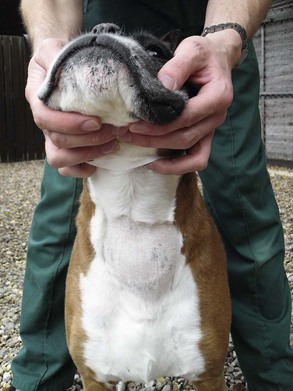Chapter 89 Affected dogs usually are 9 to 10 years or older. Boxers, beagles, golden retrievers, and Siberian huskies have been found to be more commonly affected in some studies. A mixed-breed family of dogs (three out of four littermates) with a significant pedigreed Alaskan malamute component in their breeding developed medullary thyroid carcinomas (Lee et al, 2006). There is no reported sex predisposition. Clinical signs depend on where the tumor is located and whether the mass is functional. The vast majority of the lesions are nonfunctional and are situated in the area of the thyroid gland; therefore a noticeable mass is by far the most common presenting sign (Figure 89-1). The average time to diagnosis is 1 to 2 months from owner appreciation of the mass. It is important to assess mobility of the mass. Roughly one third to one half of thyroid carcinomas are freely moveable at presentation, and freely mobile thyroid carcinomas have different treatment options and different prognoses from fixed carcinomas.
Thyroid Tumors
Canine Thyroid Carcinoma
Presentation
< div class='tao-gold-member'>
![]()
Stay updated, free articles. Join our Telegram channel

Full access? Get Clinical Tree



